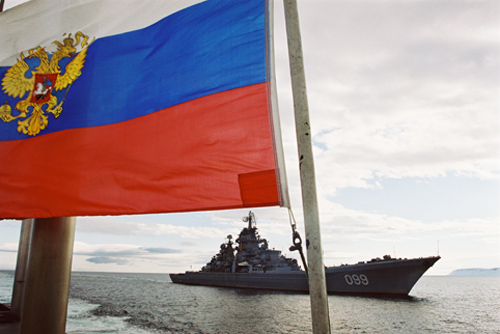
Putin Pledges Billions to Build a Blue-Water Navy
Publication: Eurasia Daily Monitor Volume: 9 Issue: 147
By:

On July 29, the Russian Navy celebrated with public pomp its founding by Tsar Peter the Great 316 years ago. In an interview with RIA Novosti on July 27 that was connected to the celebrations, the Navy’s chief, Vice Admiral Viktor Chirkov, stated Moscow was intent on keeping its naval facility in the Syrian port of Tartus. Russia would also negotiate with Cuba, Vietnam and the Indian Ocean archipelago country of the Seychelles about setting up maintenance and supply facilities for Russian ships. Chirkov also announced substantial investments into expanding nuclear submarine bases in Kamchatka and in Vladivostok. The Vice Admiral revealed that “it has been decided” the Mistral-class helicopter-carrying assault ships being constructed for Russia in France “will be based in Vladivostok after 2015” and preparatory work to build a base has begun (RIA Novosti, July 27). Ten hours later on the same day, the Defense Ministry press service repudiated Chirkov’s foreign base announcement, accusing the RIA Novosti reporter of being “unethical and incompetent,” cooking up a “sensational fantasy” (Interfax, July 27).
At present Russia lacks the ships to retain a permanent presence of combat vessels in Tartus – Russia’s only overseas military base outside the borders of the former Soviet Union. A Black Sea Fleet repair and maintenance ship is permanently moored in Tartus to offer aid in case a Russian warship needs urgent repairs. Two times a year, the maintenance ship sails back to Sevastopol from Tartus, to be replaced for the following half year by another similar naval support vessel. The land-based Russian naval garrison in Tartus is 50 men strong. According to the Russian naval command, this month, tugboats of the Black Sea Fleet pulled a new floating pier into Tartus to expand its docking capability. Yet, Russian combat ships visit Tartus only several times a year, and then stay for just a day or two (RIA Novosti, July 20).
The Russian military withdrew its military and intelligence-gathering facilities from Cuba and closed the Soviet-era naval base at Vietnam’s Cam Ranh Bay in the early 2000s, during President Vladimir Putin’s first term, to cut spending. A resumption of a Russian military and naval presence in Cuba would surely be unpopular in Washington, but a Russian naval return to a Vietnamese port would equally offend Beijing, which has a serious territorial dispute with Hanoi in the South China Sea region. In Soviet times, the Russian naval squadron based in Cam Ranh was aimed primarily against China, but today Moscow is teeming up with Beijing on a number of issues like Syria. Consequently, Chirkov seems to have overstepped by affronting the US and China – and maybe in addition India, which may not like seeing a Russian naval facility in the Indian Ocean that New Delhi sees as its backyard – all in one short interview. The RIA Novosti reporter was officially blamed for the blunder, but the denial came from the Defense Ministry – not the naval press service. In addition, the Defense Ministry press service reprimanded Chirkov’s office: “The Main Naval Command does not have the legal authority to deal with international issues and cannot make any public announcements in this field” (Interfax, July 27). It would seem that Chirkov indeed spoke about real plans to extend Russian naval power to Cuba, Vietnam and the Seychelles and was reprimanded for disclosing long-term intentions that may interfere with present foreign policy deals.
This week, Putin visited Russia’s main nuclear submarine building facility, Sevmash, in Severodvinsk on the White Sea. Putin attended a ceremony to begin the building of a new strategic Borey-class nuclear submarine “Prince Vladimir,” the fourth of its type. After the ceremony, Putin addressed an interdepartmental meeting to review the program to rearm Russia’s navy, attended by top military and defense industry officials. Putin announced the Navy will receive 4.44 trillion rubles ($138 billion) until 2020 to procure new warships and attack submarines. This sum is 23.4 percent of the overall funding that has been allocated to rearm the entire Russian military until 2020. Funding allocated to build eight new strategic nuclear submarines of the Borey class is not included, and this would add more than a trillion rubles (about $31 billion) to the overall naval expenditure. Putin announced that some 51 “modern warships will be added to the fleet, 16 attack submarines and eight strategic submarines.” Excluding two Mistral-class ships being built in France, the rest will be built domestically and “will allow Russia to defend its national interests in the world ocean.” Putin added: “We have the money, but let us spend it wisely” (www.kremlin.ru, July 30).
Russia does not plan to build new cruisers or aircraft carries – the new warships will be primarily frigates, corvettes, minesweepers, landing ships and patrol boats. A new design destroyer is being discussed. A number of Soviet-built cruisers and destroyers that are at present unseaworthy are earmarked for renovation. The plans are grandiose, but currently the Russian Navy, split between four fleets in the North, the Baltic, the Black Sea and the Pacific – along with the Caspian flotilla – may be strong on paper, but is actually small in the number of modern seaworthy ships. According to Putin, the number of modern ships in the Navy must reach 30 percent by 2016 and 70 percent by 2020 (www.kremlin.ru, July 30). The number of cruisers, destroyers, frigates and ocean-going corvettes in the entire Russian fleets today is estimated at 26 together with over 20 major landing craft (VPK, July 4). Most Russian tank-landing craft were built in Poland during the Cold War and are still in service, seeming to be of better quality than Russian and Ukrainian-made warships. After the collapse of the Soviet Union, landing-craft ships have also been used to carry commercial cargos, so there was an interest to keep them seaworthy, while warships were left to rot in port (VPK, August 1).
Today, Putin and Russian admirals have ambitions to recreate a blue-water navy, but do not have the capability. Most recently, the Russian Navy deployed a joint force of ships from the North, Baltic and Black Sea fleets into the Mediterranean, consisting of several corvettes and tank-landing ships. The force is not impressive: it lacks air cover and modern long-range weapons. Some of the ships have already returned to base (RIA Novosti, July 28). The late Russian President Boris Yeltsin is reported to have told his admirals: “I will not give any money to revive a Soviet-style navy, come back with a new concept” (VPK, July 11). Putin seems to be ready to spend a fortune to revive a grand, ocean-dominating navy, primarily built to counter the US; but this goal is still far out of reach.




